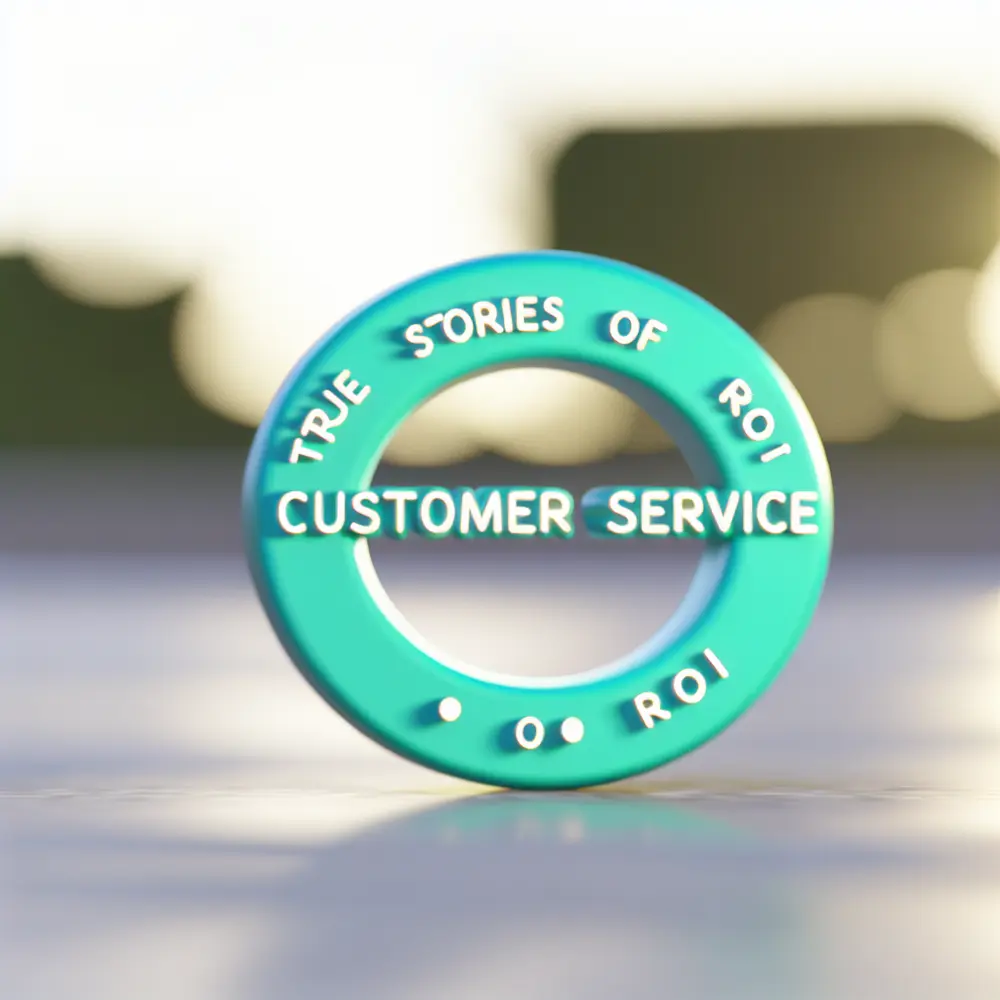Maximizing customer service ROI is crucial for long-term success in a competitive business environment. As customer expectations rise, understanding the value behind customer service investments becomes essential. Leaders in customer experience (CX) must recognize that every interaction contributes significantly to overall business performance. This article explores effective strategies to optimize customer service and achieve greater returns.
Customer service ROI measures the financial impact of resources allocated to customer support. When you implement effective strategies, you can drive improvements in customer satisfaction, loyalty, and revenue. Business professionals should not view customer service as a cost, but rather as a strategic investment that enhances market positioning and drives profitability that enhances market positioning.
Investing in cutting-edge technology can dramatically affect your business. Utilizing omnichannel support allows you to create a seamless experience, boosting customer satisfaction and operational efficiency. Understanding your return on these investments empowers you to make data-driven decisions that enhance customer retention and overall profitability with the right tools.
Understanding Customer Service ROI: What It Means for Your Business
Understanding customer service ROI is vital for measuring the effectiveness of your investments in customer support. This metric illustrates how effectively your resources contribute to enhancing customer satisfaction and driving business outcomes. As a leader, embracing this metric can directly influence and improve your company’s overall performance to drive performance.
For example, let’s take the case of “Retail Master,” a leading e-commerce platform. After revamping their customer service training program, they achieved a 20% increase in customer satisfaction scores. As a consequence, they also reported a 15% boost in sales revenue. This evidence highlights the significant financial implications of investing in robust customer service training.
Analyzing CX metrics, such as average response times and resolution rates, further aids in uncovering areas for improvement. For instance, “TechSolutions,” a tech support firm, discovered their average response time was over 24 hours. Upon implementing an omnichannel approach, they reduced it to 6 hours, which resulted in a 25% increase in customer retention. Such metrics signify the direct benefits tied to improving service processes.
Moreover, investments in technologies like an omnichannel platform not only streamline processes but also lower operational costs. “HomeComfort,” a company specializing in HVAC solutions, implemented such technology and subsequently reduced overhead costs by 20%. The streamlined communication process led to better customer service outcomes, driving a 10% increase in annual profits.
In summary, understanding customer service ROI offers invaluable insights into enhancing customer satisfaction and driving business growth. By investing strategically, analyzing metrics, and harnessing technology, you can achieve significant returns on your investment.
The Importance of Measuring CX Metrics for Effective ROI
Measuring CX metrics is vital for accurately assessing customer service ROI. By systematically tracking these indicators, you gain insight into customer behaviors and interactions, which facilitates more informed decision-making. Prioritizing these metrics allows you to allocate resources more effectively to enhance customer satisfaction.
Consider “FreshGrocer,” a grocery delivery service. By implementing routines to measure Net Promoter Score (NPS) and Customer Satisfaction Score (CSAT), they identified that timely deliveries were essential to their customers. Enhancing this aspect led to a 30% improvement in customer retention within six months.
Moreover, using advanced tools to track CX metrics helps discern patterns in customer behavior. For example, when “DigitalBooks,” a digital publishing company, analyzed customer feedback, they discovered that 70% of their customers preferred e-mail communications over phone calls. This insight led to a targeted strategy that boosted response times and enhanced customer satisfaction.
Tracking these metrics fosters a culture of continuous improvement. “ServicePro,” a customer service consultancy, observed that when they emphasized CSAT in team meetings, employee engagement increased by 25%. Happier employees led to improved customer interactions, significantly enhancing customer loyalty.
Ultimately, leveraging data-driven insights from CX metrics paves the way toward maximizing customer service ROI. Leaders must embrace these metrics as tools for elevating customer experiences and enhancing overall business performance.
Compelling ROI Case Studies: Success Stories in Customer Service
To truly grasp the value of customer service ROI, examining successful case studies provides actionable insights. These examples demonstrate that investing in customer service yields substantial financial benefits for businesses. Each case illustrates different strategies that effectively enhance service performance.
For instance, “SecureBank,” a financial institution, embraced an omnichannel service approach. By integrating their service platforms, they achieved a 30% decrease in customer complaints and enhanced operational efficiency by 25%. These improvements correlated with a 15% increase in customer retention rates, showcasing how technology investments can maximize ROI.
In another powerful example, “FashionFinder,” a retail brand, adopted AI-driven chatbots for routine inquiries. This strategy not only reduced customer wait times but improved first-contact resolution rates by 50%. These enhancements contributed to a remarkable 20% increase in sales over one quarter, illustrating the ROI from tech-driven customer service improvements.
Additionally, “GreenLeaves,” a hospitality company, initiated a training program focused on empathy and communication skills for its staff. As a result, they recorded a 40% increase in positive online reviews, which directly impacted their brand reputation. This transformation also led to a 25% reduction in customer churn, showcasing the value of investing in employee training.
Furthermore, “HealthyClinic,” a healthcare provider, revamped its patient communication strategy using omnichannel support. This overhaul increased appointment confirmations by 35%, enhancing patient satisfaction while contributing to a yearly savings of $300,000. This case exemplifies the measurable ROI from aligning service strategies with patient needs.
These compelling ROI case studies reflect the transformative potential of investing in customer service. By prioritizing customer experience, businesses unlock an array of opportunities for increased growth and profitability.
How to Calculate and Present Customer Service ROI
Calculating customer service ROI is essential for demonstrating the impact of your initiatives. Start by identifying key performance indicators (KPIs) pertinent to your business goals. Metrics like customer satisfaction, service response times, and retention rates should guide your evaluation criteria.
Once you’ve established relevant CX metrics, correlate them with financial outcomes. For example, if your customer satisfaction scores improve, analyze how this impacts sales or reduces churn rates. “SoftTech,” a software development firm, found a direct correlation between a 15% increase in customer satisfaction and a 10% uplift in revenue within a single quarter.
Moreover, presenting these insights compellingly makes your findings resonate with stakeholders. Utilize case studies to communicate how effective customer service practices have led to improvements in performance. For instance, “EventUp,” a digital event management company, demonstrated how enhancing their customer support process led to a substantial increase in client retention and overall sales.
Additionally, adopt a holistic perspective when presenting ROI. Recognize both direct and indirect benefits. While immediate sales improvements may be evident, factors like enhanced brand loyalty and lowered churn present longer-term value. “CloudTech,” a cloud services provider, exemplified this by decreasing support costs by 40%, while simultaneously maintaining high customer satisfaction levels.
Your presentation should cater to your audience’s interests, incorporating visuals like graphs to facilitate data understanding. Presenting customer service ROI through a strategic lens promotes comprehension and drives action towards optimizing customer service investments.
Key Strategies for Boosting Customer Service ROI
Boosting customer service ROI hinges on identifying actionable strategies that couple performance enhancements with customer-centric practices. Leaders should prioritize initiatives that leverage technology to optimize service efficacy, thereby driving value for the organization.
Analyzing successful case studies allows you to extract valuable lessons. For example, “InnovativeAuto” learned from industry-leading companies that investing in comprehensive CX training improved their service metrics dramatically. This insight led to a 20% increase in customer loyalty within a year.
Establishing clear CX metrics is essential for evaluating the impact of your customer service strategies. Visualizing metrics such as Net Promoter Score (NPS) or Customer Satisfaction Score (CSAT) enables organizations to quantify improvements. For example, when “HappyPets” began tracking NPS rigorously, they saw a measurable increase in customer retention, ultimately enhancing customer service ROI.
Implementing an omnichannel support strategy also significantly improves customer service ROI. Allowing customers to engage through preferred channels not only enhances satisfaction but also boosts efficiency. “GourmetCafé” adopted such strategies resulting in a 35% decrease in response times, reinforcing their commitment to excellent customer service.
Additionally, consider leveraging automation tools like chatbots to streamline support processes. These technologies alleviate workloads on human agents, ultimately enhancing customer satisfaction. “QuickSolutions” effectively adopted automation and reported a 60% increase in service response efficiency.
The Business Value of Exceptional Customer Service: Lessons Learned
Exceptional customer service has a profound impact on business value, showcasing the importance of a well-rounded Customer Service ROI strategy. Companies that prioritize quality interactions report tangible financial returns, underscoring the significance of aligning investments with customer care efforts.
For instance, “FashionGate,” a major retail outlet, invested in a dedicated customer service team, resulting in a 25% increase in retention rates. This transformation exemplifies how investing in service translates directly into revenue growth.
Similarly, proactive engagement with customers enhances satisfaction scores. “TravelBuddy,” a travel agency, revamped its service approach to integrate omnichannel support, generating a 30% uptick in positive customer feedback and an analogous improvement in overall sales, fostering new client referrals.
Moreover, investment in performance measurement tools allows organizations to quantify the ROI of their customer service strategies. By utilizing analytics, “CloudSolutions,” a tech firm, refined its interactions and recorded a 40% decrease in support costs without sacrificing customer satisfaction.
Ultimately, investing in exceptional customer service provides a competitive edge. Insights gathered from various case studies reveal that prioritizing service fosters long-term customer relationships, enabling organizations to thrive. By continually evaluating their customer service practices, leaders can adapt to evolving client demands, ensuring sustained success.
Future Trends in Customer Service and ROI: What to Watch For
The role of customer service in revenue generation continues to evolve. Emerging trends indicate significant shifts in how businesses approach customer service ROI. For instance, advanced technologies like AI are expected to enable organizations to provide increasingly personalized experiences, enhancing CX metrics significantly.
The formation of omnichannel support platforms enables communication analyses across various channels. Such integrations improve response times and provide insights into customer behaviors. For example, “GlobalTrade,” a logistics firm, noted increased service efficiency through a consolidated communication platform, thus enhancing their client experience.
As customer expectations rise, it becomes imperative to measure performance with precision. Prompt responses and customized engagements will drive organizations to implement robust performance metrics. Companies adept at understanding and adapting to these changing demands will likely experience stronger customer service ROI.
Furthermore, employee engagement will become critically important. Empowered employees are better equipped to deliver exceptional service, fostering customer loyalty. For instance, “EmployeeFirst,” a workplace consultancy, found investing in training and wellbeing resulted in a 20% increase in positive service feedback.
Continuous innovation in customer service solutions will be vital. Data-driven decision-making processes will primarily dictate success measurement. By leveraging CX metrics, organizations can identify star strategies and target areas needing attention. Thus, as awareness deepens about the direct correlation between customer service quality and revenue, strategic investments will prove crucial for maximizing ROI.
Conclusion: Harnessing Customer Service ROI for Long-term Business Success
To conclude, maximizing customer service ROI is essential for achieving sustainable growth in a fiercely competitive market. Business leaders must use ROI case studies to understand the tangible benefits of investing in customer service initiatives. The focus should be on metrics that drive customer loyalty and ultimately profit growth that drive loyalty.
Implementing effective CX metrics plays a key role in identifying areas for enhancement. As examples demonstrate, companies with high customer service ROI consistently report lower churn rates and higher average revenue per user (ARPU), signifying the importance of prioritizing the customer experience.
Establishing an omnichannel approach amplifies customer engagement effectiveness. With comprehensive support systems in place, organizations can address inquiries effectively while enhancing customer satisfaction. This strategy underscores the value of investing in omnichannel support to maximize customer service ROI.
Moreover, the positive ripples of exceptional service extend beyond financial metrics. Organizations often achieve enhanced brand reputation, inviting referrals and broader market outreach. Testimonies from successful ROI case studies reinforce that exceptional commitment to customer service transforms clients into loyal advocates.
In summary, harnessing customer service ROI is crucial for business leaders aiming for successful long-term outcomes. By prioritizing CX metrics, analyzing case studies, and implementing effective omnichannel solutions, companies can cultivate compelling business value aligned with customer expectations. This strategic focus not only drives immediate results but positions organizations for enduring growth.
For more insights on developing effective customer strategies, visit Nexloo’s Omnichannel Platform.









